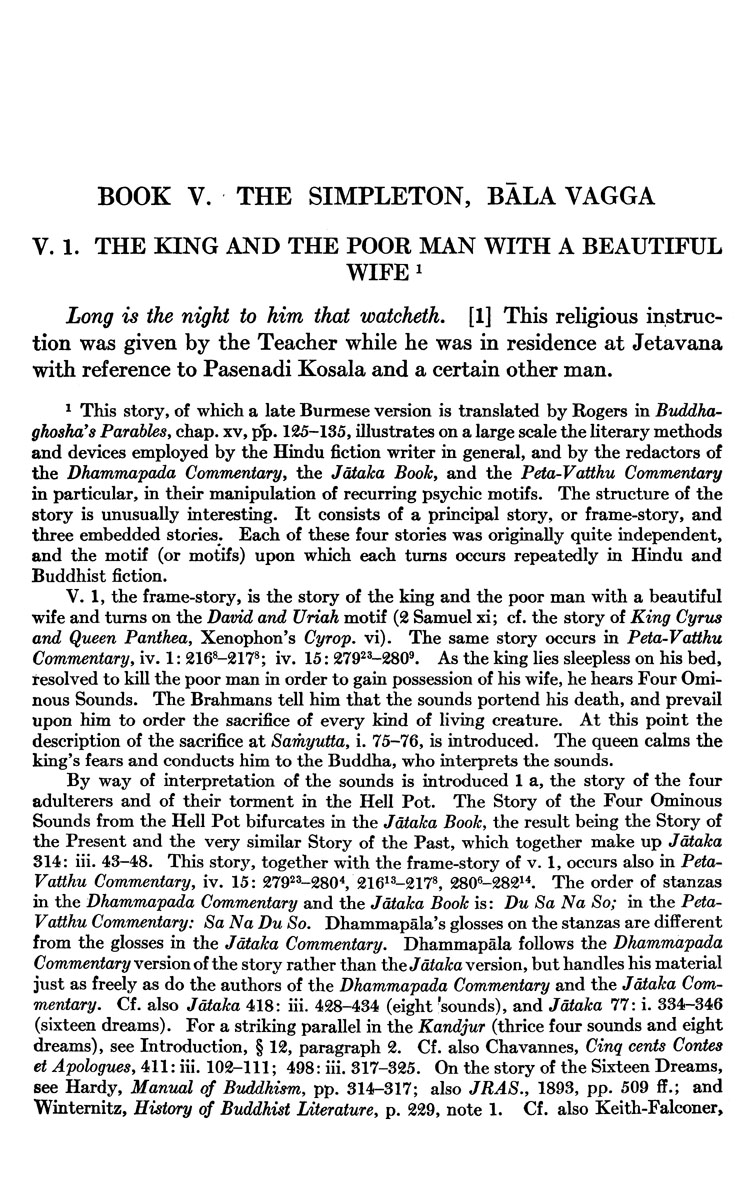BOOK V. THE SIMPLETON, BALA VAGGA
V. 1. THE KING AND THE POOR MAN WITH A BEAUTIFUL
WIFEi
Long is the night to him that watcheth. [1] This religious instruc¬
tion was given by the Teacher while he was in residence at Jetavana
with reference to Pasenadi Kosala and a certain other man.
^ This story, of which a late Burmese version is translated by Rogers in Buddha-
ghosha's Parables, chap, xv, pp. 125-135, illustrates on a large scale the literary methods
and devices employed by the Hindu fiction writer in general, and by the redactors of
the Dhammapada Commentary, the Jdtaka Book, and the Peta-Vatthu Commentary
in particular, in their manipulation of recurring psychic motifs. The structure of the
story is unusually interesting. It consists of a principal story, or frame-story, and
three embedded stories. Each of these four stories was originally quite independent,
and the motif (or motifs) upon which each turns occurs repeatedly in Hindu and
Buddhist fiction.
V. 1, the frame-story, is the story of the king and the poor man with a beautiful
wife and turns on the David and Uriah motif (2 Samuel xi; cf. the story of King Cyrv^
and Queen Panthea, Xenophon's Cyrop, vi). The same story occurs in Peta-Vatthu
Commentary, iv. 1: 216^-217^; iv. 15: 279^^-280^. As the king lies sleepless on his bed,
resolved to kill the poor man in order to gain possession of his wife, he hears Four Omi¬
nous Sounds. The Brahmans tell him that the sounds portend his death, and prevail
upon him to order the sacrifice of every kind of living creature. At this point the
description of the sacrifice at Samyutta, i. 75-76, is introduced. The queen calms the
king's fears and conducts him to the Buddha, who iaterprets the sounds.
By way of interpretation of the sounds is introduced 1 a, the story of the four
adulterers and of their torment in the Hell Pot. The Story of the Four Ominous
Sounds from the Hell Pot bifurcates in the Jdtaka Book, the result being the Story of
the Present and the very similar Story of the Past, which together make up Jdtaka
314: iii. 43-48. This storj^ together with the frame-story of v. 1, occurs also in Peta-
Vatthu Commentary, iv. 15: 27923-280^, 216i3_2i78^ 280^-282^^. The order of stanzas
in the Dhammapada Commentary and the Jdtaka Book is: Du Sa Na So; in the Peta-
Vatthu Commentary: Sa Na Du So, Dhammapala's glosses on the stanzas are different
from the glosses in the Jdtaka Commentary, Dhammapala follows the Dhammapada
Commentary version of the story rather than the Jdtaka version, but handles his material
just as freely as do the authors of the Dhammapada Commentary and the Jdtaka Com¬
mentary, Cf. also Jdtaka 418: iii. 428-434 (eight 'sounds), and Jdtaka 77: i. 334-346
(sixteen dreams). For a striking parallel in the Kandjur (thrice four sounds and eight
dreams), see Introduction, § 12, paragraph 2. Cf. also Chavannes, Cinq cents Contes
et Apologues, 411: iii. 102-111; 498: iii. 317-325. On the story of the Sixteen Dreams,
see Hardy, Manual of Buddhism, pp. 314-317; also JRAS., 1893, pp. 509 S.; and
Wintemitz, History of Buddhist Literature, p. 229, note 1. Cf. also Keith-Falconer,
|








